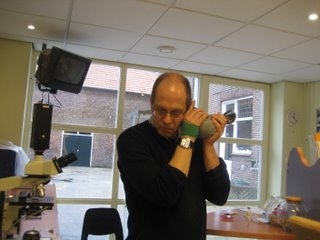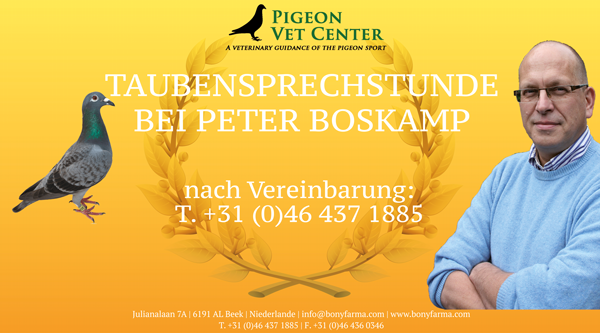Endoparasiten – von Tierarzt Peter Boskamp…
Endoparasiten
Was Würmer betrifft möchte ich hier nur die Arten besprechen, die in dieser Region vorkommen. Die meist vorkommenden Würmer bei Tauben sind Nematoden wie der Spulwurm oder Haarwurm. Der Bandwurm gehört zu den Cestoden und das Taubenknöchgen das zu den Trematoden (Saugwürmer) gehört. Wurminfektionen werden immer noch regelmässig festgestellt. Was mir einst aufgefallen ist, dass als ich zum ersten Mal von einem Taubenverein eingeladen wurde, um die Tauben vor Ort zu untersuchen, es viele Züchter gab deren Tauben eine Wurminfektion hatten. Dies tritt vor Allem auf wenn die Kontrolle nach der Flugsaison stattfindet. Die gegenseitige Infizierung in den Körben ist meistens sehr stark. Wir können dann oft feststellen, dass das Leistungsniveau eines Vereins als Ganzes enttäuschend sein kann. Nun können Wurmeier sich während langer Zeit halten, dies innerhalb und ausserhalb eines Schlages. Deswegen ist es bei Wurminfektionen immer ratsam regelmässige Kotkontrollen durchführen zu lassen.
Der Spulwurm (Ascaridae columbae)
Infektionen mit dieser Wurmart kommen noch regelmässig vor. Schläge die hiervon betroffen sind können hier bleibende Probleme behalten. Das ist u.A. deshalb, da die Umgebung des Schlags meistens auch infiziert mit Wurmeier bleibt, die dann von den Tauben wieder aufgenommen werden können. Oder durch den Züchter mit herein getragen werden, sodass die Tauben sich wieder neu infizieren können. Bei ernsten Wurminfektionen ist es vernünftig, die Schläge regelmässig auszubrennen.
Der erwachsene Spulwurm lebt im Dünndarm und wird etwa 3-7 cm lang. Das Spulwurmweibchen kann tausende Eier legen. Diese Eier sind ohne Mikroskop nicht sichtbar. Die Würmer haben einen direkten Zyklus. Das heisst, dass kein Zwischenwirt benötigt wird wie z.B. bei Bandwürmern und den Taubenknöchgen der Fall ist.
Nachdem das Weibchen die Eier gelegt hat sind diese nicht sofort infektiös. In einer warmen und feuchten Umgebung werden diese Würmer erst nach 10-14 Tagen infektiös. Infizierung in den Körben ist im Prinzip nur möglich, wenn diese nach den Flügen nicht ordentlich gereinigt und desinfiziert werden. Nimmt eine Taube frisch gelegte Wurmeier im Korb auf, haben diese schon den Darm passiert bevor sie ansteckend sind.
Nimmt eine Taube infektiöse Wurmeier auf dann kommen diese im Taubendarm an. Die Spulwürmer leben im Dünndarm der Taube. Die Larven, die aus den Eiern kommen kriechen in Richtung Schleimhaut der Darmwand worin sie sich einnisten. In die Darmwand häuten die Larven sich mehrere Male. Diese ersten larvale Stadien sind nicht empfindlich für die bestehenden Wurmmittel. Deswegen soll eine Wurmkur immer wiederholt werden, bevor diese Larven, die noch nicht empfindlich waren „erwachsen“ geworden sind und selber wieder Eier produzieren können. Die Periode zwischen der Infektion und dem Moment, da die erwachsenen Würmer selber wieder Eier produzieren können, nennen wir die präpatente Periode. Diese dauert bei Spulwürmern etwa 30-40 Tage.
Pathogenität und klinische Erscheinungen
Die Schädlichkeit der Spulwürmer ist in Bezug zur krankheitserregenden Fähigkeit nicht ganz so schlimm. Trotzdem dürfen wir eine Infektion mit Spulwürmer nicht unterschätzen. Einige Spulwürmer können die Kondition der Tauben doch etwas senken. Weil der Taubensport inzwischen Topsport geworden ist kann man es sich nicht leisten, eine Wurminfektion unbehandelt zu lassen. Die Spulwürmer essen sozusagen mit der Taube mit und nehmen ein Teil der Minerale, Vitamine und Spurenelemente des Wirts auf. Dazu natürlich auch noch andere Nahrungsstoffe. Die Verringerung der Verfügbarkeit der Mikronahrungsstoffe ist mitunter der Grund dafür, dass die Tauben schlechter die Daunen fallen lassen. Bei schwereren Infektionen magern die Tauben ab und die Kondition leidet noch mehr. Die Tauben ermüden auch schneller. Auch kann Durchfall vorkommen, wobei der Kot zuerst wie Brei wird. So oder so werden die Tauben durch den Angriff der Abwehr auch empfindlicher für andere Infektionen.
Manchmal kann eine Taube sogar an einer schweren Wurminfektion sterben. Das kann passieren wenn so viele Wurmeier im Darm sind, dass sozusagen eine Darmverschluss autritt.
Tauben, die festsitzen haben meist mehr Probleme mit Würmer. Möglicherweise deshalb da bei den Reisetauben eher der Entschluss gefasst wird, eine Kotuntersuchung machen zu lassen. Auf Taubenschlägen sollte man Ecken, Nähte und Spalten nicht vergessen sobald eine Wurminfektion festgestellt wurde. Wie gesagt soll bei einer festgestellten Wurminfektion neben der Behandlung der Tauben auch der Schlag ausgebrannt werden. Dies wegen der Wurmeier. Desinfektionsmittel bringen nicht viel bei einer Wurminfektion. Um vorzubeugen, dass man die Wurmeier mit dem Brenner auch wirklich erwischt, ist es ratsam den Boden und die Spalten zuerst anzufeuchten und erst danach zu brennen.
Kalte und ungünstige Wetterbedingungen können Wurmeier gut vertragen. Bei einer feuchten Wärme findet die Entwicklung sogar schneller statt und wird die Infektion sich einfacher entwickeln können.
Es gibt diverse Mittel zur Bekämpfung von Rundwurminfektionen. Eine alte Warnung muss hier wiederholt werden. Febendazole (Panacur) ist ein Wurmmittel das dramatische Federschäden verursachen kann wenn es während der Mauser benutzt wird. Dies sollte dann auch vermieden werden!
Andere gut wirkende Wurmmittel sind auf Basis von Levamisole und Febantel. Persönlich bevorzuge ich die Mittel auf Basis von Flubendazole. Am besten eine inidividuelle Behandlung.
Avermectine werden auch als Kombinationsmittel gegen sowohl Würmer als auch Ektoparasite benutzt. Meistens sind diese Mittel auf Basis von Ivermectin. Diese Mittel sind immer noch gut wirksam. Es gibt Varianten wodurch die Tropfen gut durch die Haut aufgenommen werden. Diese haben meistens eine bessere Wirkung als die Tropfen, die sich auch zur Injektion eignen. Persönlich rate ich davon ab, die Mittel auf Avermectinbasis während der Flugsaison bei den Reisetauben zu benutzen Dies da der Eindruck besteht, dass der Formaufbau der Tauben hierdurch drastisch zerstört wird.
Der Haarwurm (Cappilaria obsignata)
Neben Infektionen mit Cappilaria obsignata werden auch Infektionen mit Cappilaria caudinflata gemeldet. Dieser Wurm ist nur 18 mm lang und wird also nicht im Kot bemerkt. Er lebt in der Darmwand und ist viel schadhafter als der Spulwurm. Ein Paar Haarwürmer sind schon im Stande die Kondition einer Tauben total zu untergraben und die Form zunichte zu machen. Wie beim Spulwurm müssen auch die Eier des Haarwurms erst eine Reifung durchleben, am liebsten in einem feuchten und warmen Milieu. Die Eier sind bei mikroskopischer Untersuchung leicht zu erkennen. Schon die Anwesenheit von nur wenigen Haarwürmern können der Grund sein für eine starke Abmagerung der Tauben, Konditionsverlust, weniger Daunen und Durchfall. Leistungen gehen zurück. Bei einer heftigen Infektion kann es nach einer Behandlung lange dauern bevor die Tauben wieder ausreichend Kondition und Körpermasse aufgebaut haben. Spitzenleistungen sind nach eine schweren Haarwurminfektion auf kurze Dauer nicht mehr zu erwarten.
Cappilaria obsignata hat einen direkten Zyklus. Der Wurm ist nicht tierartspezifisch. So können Hühner und Fasane auch als Quelle einer Infektion für die Taube sein. Cappilaria caudinflata hat keinen direkten Zyklus. Hierfür ist der Regenwurm der Zwischenwirt. Die Haarwurmeier können schon nach 8-10 Tagen infektiös sein. Das ist etwas schneller als bei Spulwurmeier.
Im Allgemeinen gilt, dass Tauben nicht gegen Würmer in der Mauser und in der Zuchtperiode behandelt werden sollen. Auch ist die Behandlung von Tauben während des Fütterns der Jungen unerwünscht.
Ihr
Peter Boskamp
Werbung:
Pigeon Vet Center
Julianalaan 7a, 6191 AL BEEK (Limburg) NL
E-mail: info@pigeonvetcenter.com
Telefoon: 0031 46 4371885
Fax:0031 46 4360346
 en.Neben der Anwendung regulierer Medikamente nimmt die Anwendung alternativer tiermedizinischer Mittel (z.B. Kräuter) einen hohen Stellenwert ein.Wir bemühen uns in der Praxis, durch regelmäßige präventive Gesundheitskontrollen übermäßigen Gebrauch von Medikamenten zuvorzukommen. Mit dem gleichen Ziel wird die Anwendung abwehrstärkender Kräuter eingesetzt. Obengenannte Methoden sorgen in Kombination mit präventiven Impfungen dafür, daß die Tauben mit erhöhter Abwehr in die Saison starten können.Auf diese Art können auch unnötigen Kuren während der Saison zuvorgekommen werden, so daß Zeit und Raum zur Verbesserung der Form der Tiere und somit zur höheren Leistungsfähigkeit entstehen können.
en.Neben der Anwendung regulierer Medikamente nimmt die Anwendung alternativer tiermedizinischer Mittel (z.B. Kräuter) einen hohen Stellenwert ein.Wir bemühen uns in der Praxis, durch regelmäßige präventive Gesundheitskontrollen übermäßigen Gebrauch von Medikamenten zuvorzukommen. Mit dem gleichen Ziel wird die Anwendung abwehrstärkender Kräuter eingesetzt. Obengenannte Methoden sorgen in Kombination mit präventiven Impfungen dafür, daß die Tauben mit erhöhter Abwehr in die Saison starten können.Auf diese Art können auch unnötigen Kuren während der Saison zuvorgekommen werden, so daß Zeit und Raum zur Verbesserung der Form der Tiere und somit zur höheren Leistungsfähigkeit entstehen können. Mehrmals per Jahr senden wir Informationen für Taubenliebhaber sowie eine Übersicht von im Taubensport häufig benutzten Medikamenten an alle bei uns registrierten Taubenzüchter. Auf Wunsch verschicken wir außerdem regelmäßig per E-Mail Informationen über neue Entwicklungen, neue Produkte und andere für den Taubensport relevante Informationen.
Mehrmals per Jahr senden wir Informationen für Taubenliebhaber sowie eine Übersicht von im Taubensport häufig benutzten Medikamenten an alle bei uns registrierten Taubenzüchter. Auf Wunsch verschicken wir außerdem regelmäßig per E-Mail Informationen über neue Entwicklungen, neue Produkte und andere für den Taubensport relevante Informationen.




